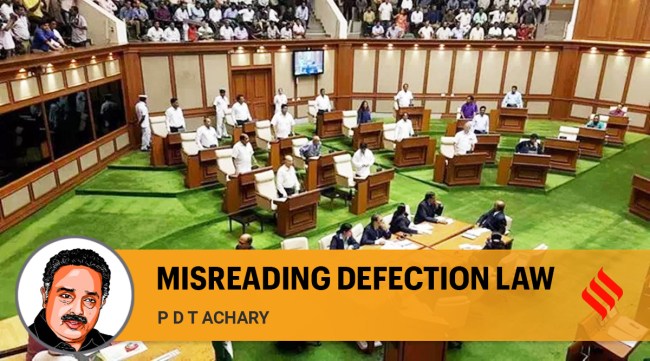Opinion A judgement that could open floodgates to defection
P D T Achary writes: In its verdict in the Goa MLAs case, Bombay High Court has misread the 10th schedule of the Constitution, which was meant to prevent horse trading among legislators.
 Ten of the 15 MLAs of the CLP in the Goa Assembly — two-thirds of the party’s strength in the House — had joined the BJP. (File Photo)
Ten of the 15 MLAs of the CLP in the Goa Assembly — two-thirds of the party’s strength in the House — had joined the BJP. (File Photo) The High Court of Bombay at Goa in its judgment, delivered on February 25, held that the former members of the Congress Legislature Party (CLP) in the Goa assembly who had defected to the BJP are exempt from disqualification under paragraph 4(2) of the Constitution’s Tenth Schedule, referred to commonly as the anti-defection law. The court said that under sub-paragraph (2) of paragraph (4), the merger of this group of Congress MLAs with the BJP is deemed to be a merger of the original political party (Indian National Congress) with the BJP. Therefore, these members are protected under paragraph (4).
Paragraph (4) of the Tenth Schedule exempts defectors from disqualification if their original political party merges with another party and two-thirds of the members of that party in the legislature agree with the merger. Ten of the 15 MLAs of the CLP in the Goa Assembly — two-thirds of the party’s strength in the House — had joined the BJP.
However, the basic premise of the February 25 judgment is that sub-paragraph (2) is distinct from the parent paragraph, and a factual merger of the original political party is not necessary. This does not square with the content, context and thrust of paragraph (4), which contemplates the factual merger of the original political party — in this case, the INC. The court’s view — the merger of the 10 MLAs of the CLP with the BJP should be regarded as the Congress itself merging with the BJP — goes against the letter and spirit of the Tenth Schedule, paragraph (4) in particular.
Paragraph (4) is an exception to the Tenth Schedule’s main provisions. It operates only when the defectors’ original political party has merged with the party to which they have defected and two-thirds of the members of the legislature belonging to that party have agreed to the merger. Under this provision, the merger of the original political party has to take place first, followed by two-thirds of the MLAs agreeing to that merger.
The High Court has made much of the following words in sub-paragraph (2): “The merger of the original political party of a member of the House shall be deemed to have taken place, if and only if, not less than two thirds of the members of the legislature party concerned have agreed to such merger”. But the opening words of sub-paragraph (2) — “for the purposes of sub-paragraph (1) of this paragraph” — clearly mean that to exempt a member from disqualification on account of defection, and for considering this member’s claim that he has become a member of the party with which the merger has taken place, a merger of two political parties alone is not enough. Not less than two-thirds of the members should also agree to such a merger. The lawmakers made it tough for potential defectors to defect.
For the adjudicating authority to entertain a claim by a member that his original political party has merged with another party, and that he has become a member of such party after the merger, he also needs to show that two-thirds of his fellow members have agreed to such a merger. The words “such merger” make it clear beyond any shadow of doubt that the merger of the original political party has to take place before two-thirds of the members agree to such a merger.
The HC seems to have missed the significance of the words “such merger”. In fact, the members of the legislature cannot agree among themselves to merge as the court has said, but they can agree to a merger after it takes place. The court has further said, erroneously, that the two sub-paragraphs 1 and 2 of paragraph 4 should be seen as independent entities. The error in the verdict seems to have occurred here. The second sub-paragraph is, in fact, a continuation of the first sub-paragraph and is in the nature of an explanation. The first sub-paragraph cannot be a code in itself because the claim of a member for exemption from disqualification cannot be decided independently on the basis of sub-paragraph (1). It can be decided only when paragraph (4) is read as a whole. The error in the judgment is obvious here.
The anti-defection law was designed to eliminate political defection. However, the judgment of the Bombay HC seems to assume that paragraph (4) of the 10th schedule is meant to facilitate defection. This judgment is likely to open the flood gates to defection. The Supreme Court must intervene quickly.
This column first appeared in the print edition on March 1, 2022 under the title ‘Misreading defection law’. The writer is former Secretary General, Lok Sabha





